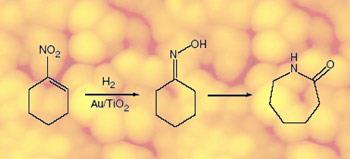Gold nanoparticles speed up clean reduction of aromatic nitro compounds.
Aminobenzene chemicals are used to make anything from dyes to pharmaceuticals, and now scientists have found a way to produce them in a more efficient way using a gold catalyst.

Platinum or palladium catalysts are normally the catalyst of choice to help hydrogen gas reduce aromatic nitro compounds into amines. But these reaction conditions can pepper the whole molecule with unwanted hydrogen atoms, reducing other parts of the molecule as well as the nitro groups.
To improve the selectivity, so that only the nitro groups are reduced, other compounds such as vanadium salts can be added. Unfortunately, these additives can sometimes create unwanted byproducts such as hydroxylamines, which are potentially explosive.
Avelino Corma and Pedro Serna, both chemists at the Polytechnic University of Valencia, have found a way to avoid the hydroxylamine problem by using gold nanocrystals supported on either titanium or iron oxides.
The pair also found that under certain conditions, the selectivity of the gold catalyst was higher than the commonly-used platinum catalysts. They describe the research in this week’s Science magazine.
’With this technique we obtained high conversion and high specificity,’ Corma told Chemistry World. ’Up until now there was not a clean technique to do this.’ Eliminating vanadium compounds and other additives from the reaction reduces waste as well: ’the [gold] catalyst allows you to carry out a ’green’ chemical process,’ he added.
’There is real interest in using gold as a catalyst and this is a further outstanding example of what gold is capable of,’ said Graham Hutchings, a chemist at Cardiff University, UK. ’Corma shows that gold is really useful as a hydrogenation catalyst, and far more selective than platinum or palladium.’
The chemists admit that they do not yet understand why gold is better at catalysing the reaction than platinum or palladium. ’We are now working on understanding the mechanism,’ says Corma, ’and we still need to improve the activity [of the catalyst].’
Jessica Ebert
References
A Corma and P Serna, Science313, 332






No comments yet